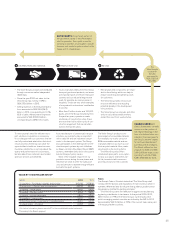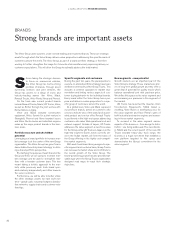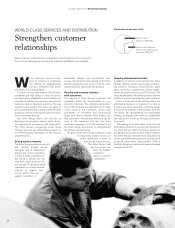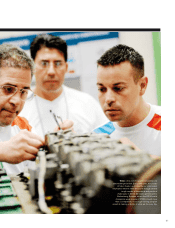Volvo 2013 Annual Report Download - page 37
Download and view the complete annual report
Please find page 37 of the 2013 Volvo annual report below. You can navigate through the pages in the report by either clicking on the pages listed below, or by using the keyword search tool below to find specific information within the annual report.
A GLOBAL GROUP 2013 AVSNITT
WWF is one of the world’s largest and most
respected environmental organizations. Its Climate
Savers Program involves multinational companies
in the effort to reduce carbon dioxide emissions.
Each company pledges to reduce its emissions fol-
lowing an agreement made with WWF. The results
are reviewed by independent experts. The agreed
target must be more ambitious than the company
would have set on its own, and must also signify
that the company is leading its sector in the reduc-
tion of greenhouse gas emissions.
In 2010, the Volvo Group became the world’s
fi rst automotive industry manufacturer approved by
WWF to participate in the program. In 2012, Volvo
CE and Volvo Buses joined. Volvo Group’s SDLG
became the fi rst Chinese company to be approved.
In the agreement Volvo Group is committed to
reducing:
• the total amount of carbon dioxide (CO2) emitted
by the Group’s trucks, construction equipment
and buses by more than 30 million tons by 2014,
compared with vehicles manufactured in 2008
• CO2 emissions from our production plants by 0.2
million tons (12%) before 2014, compared with
2008.
Our agreement also states that:
• the Volvo Group will develop a new truck proto-
type with 20% lower fuel consumption than a
corresponding truck manufactured in 2008 and
offer commercial trucks that operate on renewa-
ble gas before 2014
• Volvo CE will prepare a new prototype with con-
siderably improved fuel effi ciency compared with
existing models
• Volvo Buses will expand the number of fi eld tests
with plug-in hybrid buses.
Interim results
Five out of the six years of the program are com-
pleted. Results for the period 2009–2012 (fi gures
for 2013 will be available in June 2014) indicate
that the Volvo Group is already ahead of target in
key areas:
• CO2 emissions from the Group’s facilities have
been reduced by 0.3 million tons, making them
13% lower than in 2008
• total lifetime emissions of the Group’s products
have been reduced by 29 million tons.
Extended cooperation
WWF and Volvo Group frequently meet to discuss
environmental issues. During 2013 WWF partici-
pated in the Logistik & Transport trade fair in
Gothenburg, Sweden with the aim to give visitors
WWF’s view on Volvo Group products’ environ-
mental performance.
WWF also took part in a round table discussion
with Volvo CE’s key customers. The idea was to
give the customers an objective assessment of
Volvo CE’s environmental improvements.
During 2013 WWF Sweden visited Volvo CE in
Eskilstuna and WWF US visited Volvo CE in Ship-
pensburg to learn more and to discuss environ-
mental aspects of our products and our production.
At the WWF Climate Savers annual meeting in
Mexico City, Volvo Mexico was invited to demonstrate
hybrid buses and Bus Rapid Transit solutions.
2006
Euro 4
2009
Euro 5
2007
EPA 2007
2002
EPA 2002
2014
Euro 6
2010
EPA 2010
Particulates, g/kWh NOx, g/kWh
8
6
4
2
0
Europe USA
Particulates, g/kWh NOx g/kWh
0.16
0.12
0.08
0.04
02002
Euro 3
Emissions regulations for trucks and buses
In January 2010, EPA 2010 was implemented in North America and at the end
of 2013 Euro 6 was introduced in the EU. With the implementation of EPA
2010, emission levels for particulates and nitrogen oxides (NOx) are close to
zero. Euro 6 entails that emissions of nitrogen oxides and particulate matter
are reduced by more than 95% compared to a truck from the early 1990s.
2000
0
20
60
40
80
120
100
1995 2005 2010 2015 2020 Source: ACEA – European
Automobile Manufacturers'
Association.
Particulate matter (PM)
from diesel
Sulphur dioxide (SO2
)
Solvents (VOCs)
Carbon dioxide (CO2 )
Carbon monoxide (CO)
Nitrogen oxides (NOX)
Benzene
Signifi cantly reduced emissions
Within the EU all road transport emissions except for carbon dioxide are
expected to decrease in the future. This is the result of stringent emission
regulations..
7285949
Producing the truck
Fuel consumption
Emissions
Maintenance
(43)
Use Phase
Recycling
Each new product from the Volvo Group shall have less environmental
impact than the product it replaces. The Group uses Life Cycle Assess-
ments (LCA) to map a product’s environmental impact in order to make
well-informed decisions in the development process.
Findings from analyses indicate over 90% of the environmental impact
results from the use of the products. The Group’s main focus is therefore
on reducing the environmental impact of products in use.
The graph above shows the environmental impact of the new Renault
Trucks T 4x2 Euro 6 tractor.
Life Cycle Assessments broaden the perspective
What will follow US 10 and Euro 6?
The introduction of increasingly strict emission regulations, primarily focusing
on nitrogen oxides and particulates, has meant that the emissions caused by
vehicles sold in the market today are at very low levels. For example, the Euro 6
legislation, that came into effect in the EU at the end of 2013 entails that
emissions of nitrogen oxides and particulate matter from new trucks will be
reduced by more than 95% compared to a truck from the early 1990s. During
the year, Volvo Group introduced new trucks with a Euro 6 engine program
ranging from the smallest medium-duty 5-liter engine to the heavy-duty
13-liter version.
But what is the next step? Rules were introduced in the U.S. that approxi-
mately corresponded to Euro 6 already in 2010. Starting with model year 2014
greenhouse gas emissions and fuel consumption are regulated, targeting
considerable improvements against a 2010 baseline. All of the Volvo Group’s
truck models in the U.S., both Mack and Volvo branded, are certifi ed in
accordance with 2014 fuel effi ciency and greenhouse gas regulations.
The EU target is that greenhouse gases are to be reduced by a total of
20% between 2008 and 2030, and by at least 60% by 2050 with 1990
as the base year. The target for city transport is largely carbon-neutral
logistic solutions in major cities by 2030. The EU states that new vehicle
technology includes engines, materials and design, traffi c planning and
use of purer forms of energy through new drivelines and alternative fuels.
All of these are priority areas in the Volvo Group.
33
























